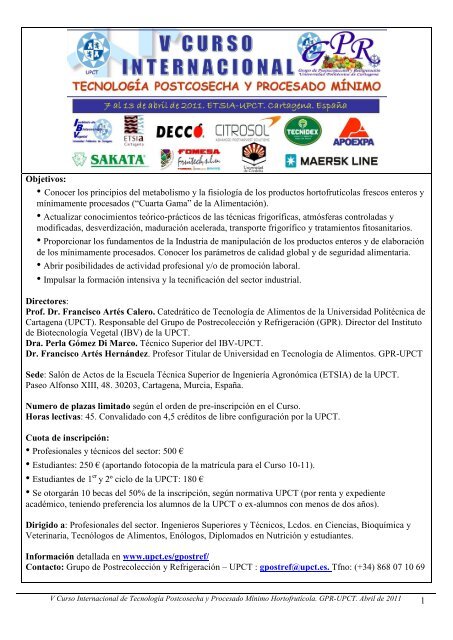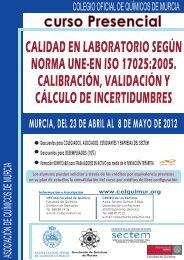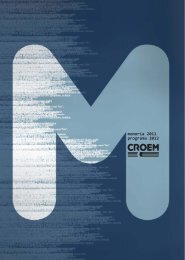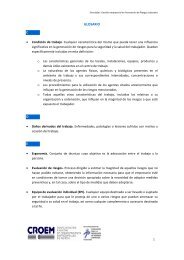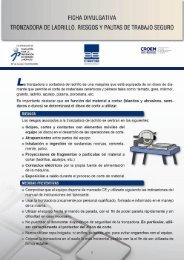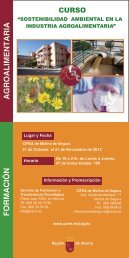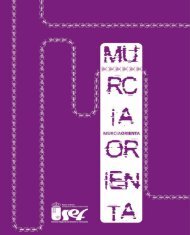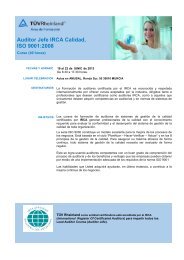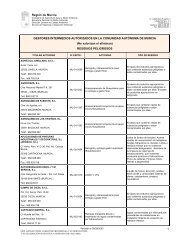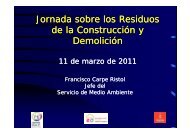CURSO: âGESTIÃN DE CALIDADâ - Campus Mare Nostrum
CURSO: âGESTIÃN DE CALIDADâ - Campus Mare Nostrum
CURSO: âGESTIÃN DE CALIDADâ - Campus Mare Nostrum
You also want an ePaper? Increase the reach of your titles
YUMPU automatically turns print PDFs into web optimized ePapers that Google loves.
12.30-13.30R. Oria AlmudíUNIZAR13.30-15.00 COMIDA LIBRE15.00-16.0016.00-17.00V.H. Escalona ContrerasUChileJ. Rueda AlamedaMAERSK S.L.U.17. Proceso general de elaboración de los productos MPF: frutas.18. Transporte frigorífico terrestre y aéreo de productoshortofrutícolas.19. Transporte frigorífico marítimo de productos hortofrutícolas.17.00-20.00 MAERSK S.L.U. VISITA TÉCNICA: instalaciones del Puerto de Cartagena.MARTES 12 <strong>DE</strong> ABRIL <strong>DE</strong> 20119.00-10.00P. Gómez Di Marco 20. Influencia de factores precosecha en la calidad de los productosUPCT MPF. Alteraciones más frecuentes.10.00-11.00B. Teruel Mederos 21. Envases y embalajes de productos hortofrutícolas. Diseño yUNICAMP Normalización.11.00-11.30 <strong>DE</strong>SAYUNO– Cafetería <strong>Campus</strong> Alfonso XIII11.30-12.30A. TurattiTURATTI SRL22. Equipamiento en el procesado mínimo hortofrutícola.12.30-13.30V. Gilabert Escrivá 23. Gestión y calidad de la materia prima y del proceso deVERDIFRESH S.L.U elaboración de productos MPF. Visión empresarial.13.30-15.00 COMIDA LIBRE15.00-16.0016.00-17.00L. Luchsinger LagosUChileE. Mercado SilvaUniv. A. Querétaro24. Tecnología postcosecha de uva de mesa.17.00-20.30 GPR- UPCT VISITAS TÉCNICAS21.30 h CENA <strong>DE</strong>L <strong>CURSO</strong>25. Tecnología postcosecha de productos tropicales y subtropicales.MIERCOLES 13 <strong>DE</strong> ABRIL <strong>DE</strong> 20119.00-10.00L. Luchsinger LagosUChile26. Tecnología postcosecha de frutos de hueso y de pepita.10.00-11.00G. Colelli 27. Calidad de la materia prima hortofrutícola para el procesadoUniv. Foggia mínimo. Factores determinantes.11.00-11.30 <strong>DE</strong>SAYUNO– Cafetería <strong>Campus</strong> Alfonso XIII11.30-12.30L. Cisneros Zevallos 28. Fisiología y metabolismo de los productos MPF. PropiedadesUniv. Texas bioactivas y funcionales.12.30-13.30E. Aguayo Giménez 29. Lavado y desinfección convencional y emergente de productosUPCT MPF.13.30-15.00 COMIDA LIBRE15.00-17.00 GPR - UPCT Taller en Planta Piloto: Procesado mínimo hortofrutícola.17.00-18.0018.00-19.0019.00-19.30J.C. Pech 30. Avances en biotecnología aplicada a la postrecolecciónUniv. P. Toulouse hortofrutícola.Adel A. Kader31. Future research needs in postharvest and fresh-cut technologies.UCDavisClausura del Curso y entrega de Diplomas a cargo de los organizadores, patrocinadores ycargos académicos de la UPCTV Curso Internacional de Tecnología Postcosecha y Procesado Mínimo Hortofrutícola. GPR-UPCT. Abril de 2011 3
3.5 Analysis of the AlgorithmDSPapprox is a very efficient algorithm. Given a vocabularysize of n, t candidate topic terms, and a goal ofselecting k topics, the algorithm performs in O(ktn) time.In contrast, the entropy-based algorithm mentioned aboveperforms in O(kn 3 ) where the Big-O is hiding a number oftime intensive computations as well many more steps in theinitialization part of the algorithm before topic terms canbe selected.Figure 2: A Dominating Set hierarchy created forTREC query 319: New Fuel Sources, where the windowsize is 5 for the top level, is 2 for the secondlevel, and is 1 for the third level (x=5,2,1).In line eight of Figure 1, we choose the heaviest vertex,d, in the set of candidate topic terms to be a member ofthe set D. We then determine the set of vertices adjacentto d that are dominated by the topic term, by using thethreshold that was calculated. The reason that edges withweights that are less than the threshold are part of the overallweight of the vertex but are not used to determine whichvocabulary terms are dominated is that the accumulation ofinfinitesimal weights allows one to distinguish topics fromthe terms they dominate by breaking the symmetries inherentin the affinity measure.In order to ensure that the second topic selected has adjacencieswith different terms, we adjust the weights of thevertices by subtracting the weights of edges to vocabularyterms dominated by d. The algorithm loops through, pickingthe heaviest vertex each time. At each step, the newheaviest vertex is added to the set D. We continue to augmentD until either all the vocabulary vertices are in the setof dominated vocabulary, or we accumulate k topic terms.3.4 Creating the HierarchyAlgorithm DSPapprox creates the top level of the hierarchy.In order to create subsequent levels, a language modelis computed for each level. This models only the terms usedin close proximity to the topic terms at the higher levels,and enables us to construct a hierarchy of topics, subtopics,sub-subtopics, and so on. The language model for the secondlevel of the hierarchy is created using conditional probabilitiesof the form P x,Cy (A|B), where A is the possible topicterm which occurs within x or fewer terms of B, the vocabularyterm as before. However, the parent term C mustbe with y or fewer terms of A to be considered a valid occurrenceof the topic term A. By changing the allowabledistance between terms, we can control how closely termsare related at different levels of the hierarchy. Once theprobabilistic model is constructed, it can be turned into agraph, and the topic terms can be selected by DSPapprox.4. EXAMPLE RESULTSEvaluating automatically generated hierarchies is a particularlydifficult task. Since summaries are created with usersin mind, a user study is the most intuitive form of evaluation.However, user studies generally yield ambiguous resultswhose significance is difficult to ascertain[5]. Especiallybecause we believe our model needs further refinement, thehierarchies are not yet ready to evaluated by users.Recently, there have been a few interesting forms of automaticevaluation for single document summaries. In Wittenet al[17], the keywords found automatically were comparedto the keywords named by the author of the particular document.In Berger and Mittal[2], the Open Directory Projectwas used, which utilizes human-generated summaries. Unfortunately,these evaluations cannot be adapted to this typeof multi-document summary because no comparable humangenerated hierarchies exist for the document sizes we areinterested in.When evaluating multi-document summaries, many researchershave developed system dependent evaluations thatevaluate individual parts of the system. For example, manyof these summaries make use of clustering [11, 14], so thequality of the cluster is useful for the evaluation. Our proposedsummaries are quite different, so this approach toevaluation cannot be adapted. Instead we use evaluationmetrics that we developed for the evaluation of subsumptionand lexical hierarchies[7].In this paper we will present both qualitative and quantitativeevaluations. This section shows an example of thetype of hierarchy the DSP technique creates, and then manuallycompares the top levels of terms chosen for severalwindow sizes of the DSP technique with the terms chosenas the top level of the subsumption and lexical hierarchies,as well as the top TF.IDF terms for the documents. In thefollowing section we introduce a new evaluation of the termsselected at the top level using a measure of predictivenessand adapt our previous evaluation approach to determinegeneral performance measures for the top levels of the hierarchiescompared to hierarchies with two levels.4.1 Example HierarchyThe multi-document sets that we are summarizing in thispaper are retrieved sets for the TREC queries 301 to 350[16].The sets consist of five hundred retrieved documents fromTREC volumes 4 and 5. The example that follows is the hierarchycreated from the documents retrieved for query 319,which is about new fuel sources. The hierarchy we create isnot intended to be a summary for the query, but rather asummary of the documents, which ideally will expose topicsrelated to the query as well as those that are unrelated.In the hierarchy shown in Figure 2, a couple of examplesof exposing unrelated topics are the two documents about a
Universidad. Departamento de Bromatología y Tecnología de los Alimentos. EscuelaTécnica Superior de Ingenieros Agrónomos y de Montes. Vicerrectora dePlanificación y Calidad de la Universidad de Córdoba (UCO). España.Dra. Victoria Gilabert Escrivá. Ingeniero Agrónomo. Departamento ICI – ResponsableDesarrollo de Procesos. VERDIFRESH S.L.U. Valencia. España.Dr. Alessandro Turatti. Ingeniero industrial. Fresh-cut Technologist. Director Técnico deTURATTI SRL. Cavarzere, Venecia. Italia.Dr. Andrés Conesa Bueno. Ingeniero Agrónomo. Diplomado en Ingeniería y Aplicacionesdel Frío en la Conservación de Vegetales. Fundación Tecnova. Almería. España.Dr. Benito Orihuel Iranzo. Químico. Director General de PRODUCTOS CITROSOL S.A.Valencia. España.Dr. Ernesto Conesa Roca. Licenciado en Ciencias Químicas. Director Técnico FomesaFruitech. Grupo Food Machinery España S.A. (FOMESA). Valencia. España.Dr. Jordi Graell i Sarlé. Ingeniero Agrónomo. Profesor en el Área de Postcosecha de laUniversidad de Lleida e Investigador del Institut de Recerca i Tecnologia Agroalimentàries(UdL-IRTA). España.Dr. José Mª Martínez Jávega. Ingeniero Agrónomo. Director del Centro de TecnologíaPostcosecha del Instituto Valenciano de Investigaciones Agrarias (IVIA). Moncada.Valencia. España.Dr. Juan Antonio Martínez López. Biólogo. Diplomado en Ciencia y Tecnología de laConservación de Alimentos. Profesor Contratado de Microbiología y PatologíaPostrecolección. Departamento de Producción Vegetal. UPCT. España.Dr. Juan Pablo Fernández Trujillo. Ingeniero Agrónomo. Profesor Titular de Universidaden el Área de Tecnología de Alimentos. GPR. DIA-UPCT. España.Dr. Luis Cisneros-Zevallos. Agronomist M. Sc. Postharvest Physiologist. AssociateProfessor. Department of Horticultural Sciences. Texas A&M University. EEUU.Dr. Luis Luchsinger Lagos. Ingeniero Agrónomo. Postharvest Physiologist. Director dela Escuela de Postgrado. Facultad de Ciencias Agronómicas de la Universidad deChile. Santiago, Chile.Dr. Víctor Hugo Escalona Contreras. Ingeniero Agrónomo. Diplomado en Ingeniería yAplicaciones del Frío en la Conservación de Vegetales. Director del Centro deEstudios de Postcosecha. Facultad de Ciencias Agronómicas de la Universidad deChile. Santiago, Chile.Dña. Ana Belén González García. Ingeniero Agrónomo. Consultor de Calidad y MedioAmbiente. Departamento Técnico de la Federación de Cooperativas Agrarias de laRegión de Murcia (FECOAM). España.D. Alejandro Tomás Callejas. Ingeniero Agrónomo. Master en Técnicas Avanzadas enInvestigación y Desarrollo Agrario y Alimentario. Becario predoctoral en el Área deTecnología de Alimentos. GPR. DIA-UPCT.D. Álvaro Payá Gonzalo-Bilbao. Ingeniero Agrónomo. Departamento Técnico deTECNI<strong>DE</strong>X, Técnicas de Desinfección S.A.U. Valencia. España.D. Enrique Gómez Hernández. Químico. Director Técnico de <strong>DE</strong>CCO IBERICA PostCosecha, S.A.U. Valencia. España.D. Ginés Benito Martínez Hernández. Ingeniero Agrónomo. Master en TécnicasAvanzadas en Investigación y Desarrollo Agrario y Alimentario. Becario predoctoralen el Área de Tecnología de Alimentos. GPR. DIA-UPCT.D. Javier Olivares Vicente. Ingeniero Industrial. Departamento Técnico de TECNI<strong>DE</strong>X,Técnicas de Desinfección S.A.U. Valencia. España.D. Javier Rueda Alameda. Capitán de la Marina Mercante. Director Técnico de MAERSKESPAÑA S.A. Algeciras, Cádiz. España.D. Mariano Otón Alcaraz. Ingeniero Técnico Agrícola. Master en Técnicas Avanzadas enInvestigación y Desarrollo Agrario y Alimentario. Técnico Contratado del IBV-UPCT. España.V Curso Internacional de Tecnología Postcosecha y Procesado Mínimo Hortofrutícola. GPR-UPCT. Abril de 2011 5
PARA REALIZAR LA PRE-INSCRIPCION EN EL <strong>CURSO</strong>Complete el formulario de pre-inscripción de esta hoja y envíeloo por correo electrónico (gpostref@upct.es)o o por fax (+34 968 32 54 33) a la atención de GPR.Una vez recibido el formulario y confirmado, su reserva de la plaza estará garantizada.El pago de la inscripción se realizará a partir del 15 de enero de 2011, cuando seproporcione la información bancaria sobre cómo efectuar el ingreso. Se deberá enviarescaneado el justificante del ingreso y una fotocopia del DNI o pasaporte.BOLETIN <strong>DE</strong> PRE-INSCRIPCION ALUTILICE MAYÚSCULAS PARA COMPLETAR EL FORMULARIOApellidos:Nombre:DNI/Pasaporte: Nacionalidad: Lugar y fecha de nacimiento:Dirección:Código postal:Ciudad: Provincia: País:Teléfono: Fax: E-mail:Titulación Académica:Profesional (1) Estudiante Universitario (1) Estudiante de la UPCT (1)Empresa:(1) Marcar lo que corresponda. Los estudiantes deberán aportar comprobante de la matrícula en alguna Universidad para el Curso 2010/2011.DATOS PARA ELABORAR LA FACTURA (en caso de requerirla)Nombre de la Empresa u Organismo:Dirección:Código postal:Ciudad: Provincia: País:Código de Identificación Fiscal (CIF):Fecha:V Curso Internacional de Tecnología Postcosecha y Procesado Mínimo Hortofrutícola. GPR-UPCT. Abril de 2011 6


